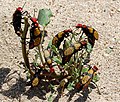Cantharidin is an odorless, colorless fatty substance of the terpenoid class, which is secreted by many species of blister beetles. Its main current use...
35 KB (3,176 words) - 07:10, 14 September 2024
Meloidae, so called for their defensive secretion of a blistering agent, cantharidin. About 7,500 species are known worldwide. Many are conspicuous and some...
11 KB (734 words) - 00:27, 24 August 2024
Lytta vesicatoria (section Preparation of cantharidin)
preparations as "Cantharides". The insect is the source of the terpenoid cantharidin, a toxic blistering agent once used as an exfoliating agent, anti-rheumatic...
19 KB (1,840 words) - 02:57, 17 August 2024
(legs, neck, and antennae). This fluid is bright orange and contains cantharidin, a poisonous chemical compound. Wiping the chemical on skin can cause...
11 KB (961 words) - 21:46, 16 September 2024
aphrodisiac effect has not been clinically tested and is achieved by cantharidin inhibition of phosphodiesterase, protein phosphatase activity and stimulation...
3 KB (270 words) - 01:43, 9 December 2023
recommended above the others to shorten infection duration. Studies have found cantharidin to be an effective and safe treatment for removing molluscum contagiosum...
26 KB (2,770 words) - 02:52, 30 August 2024
Artificial fly Fly tying In medicine Apitherapy Apitoxin Melittin Spanish fly Cantharidin In mythology Bees in mythology Cicadas in mythology Scarab (artifact)...
31 KB (3,115 words) - 13:15, 4 September 2024
chemical warfare agents, some naturally occurring substances such as cantharidin are also blister-producing agents (vesicants). Furanocoumarin, another...
4 KB (344 words) - 15:00, 29 February 2024
and pressed onto the lesion for a few moments. Trichloroacetic acid Cantharidin is an extract of the blister beetle that causes epidermal necrosis and...
18 KB (2,114 words) - 04:49, 18 September 2024
spots found on its black body. The brightness of the spots warns of the cantharidin toxins the beetle carries; this coloration is known as aposematism, and...
7 KB (738 words) - 19:26, 4 March 2024








